Today reader 45Bravo whose name is Ian does an interesting test for us with a high-end and low-end PCP shooting the new JTS .22 caliber pellets.
If you’d like to write a guest post for this blog, please email me at blogger@pyramydair.com.
Take it away, Ian.
Testing the JTS Dead Center .22 caliber 18.1gr. pellets
by Ian McKee
This report covers:
- Blurring the line
- The test
- Start with the star
- How we test
- 25 yards
- 50 yards
- The nitty gritty
Today I will begin testing the .22-caliber JTS pellets provided by JTS Airguns.
I have JTS pellets in both .22 and .25 caliber, they are marked as 18.1 grains, and 25.39 grains respectively, so I will be comparing them directly to their JSB counterparts of the same weights. Following Tom’s style, I will be doing a High/Low review style, meaning I will test the .22-caliber pellets in what is considered by many to be a high-end gun, and a low-end gun.
Blurring the line
Historically, there has always been a distinct line between expensive guns, and budget priced guns, with the emphasis being the fit/finish, build quality and accuracy. But in recent years, that line has been blurring, especially in the accuracy department, with more and more companies stepping across that line into the realm of the big boys, but still at a budget price.
The test
Today’s test will be using a JTS Airacuda standard in .22 caliber, against a Daystate Wolverine B in .22 caliber. Both guns are unregulated, and shoot at similar velocities.

Today’s test will be between two precharged pneumatic air rifles at opposite ends of the price scale. JTS Airacuda on top and Daystate Wolverine below
So today you will get a three-for-one deal (a threefer?), a mini review of two rifles you haven’t seen in this blog, and a review of the JTS pellets in both guns.
The Airacuda retails for $319 US dollars, and when last sold, the Daystate was $1695 US dollars. But is there a $1376 difference between the guns? I have been shooting these guns against each other for the last few months, and the answer to that question is surprising.
Start with the star
Let’s start with the star of today’s show, the pellets. The .22 caliber Dead Center pellets I received are in a screw top metal tin with 250 pellets per tin. There is a foam layer in the top of the tin, and surprisingly, a foam layer in the bottom of the tin as well!
I weighed ten pellets at random from the tin, and my results were in line with Tom’s experience, with nine pellets weighing 18.1-grains, and one pellet weighed 18.0-grains.
Using the Pelletgage, I had eight pellets measure 5.53mm, and two measured 5.52
The pellets are very clean, with only ONE tiny lead particle in the tin, I poured them out onto a white paper towel and checked the tin, and, after rolling the pellets around on the towel, found no other lead particles. So I feel safe to say at this point in time that JTS is serious about the quality of their pellets!
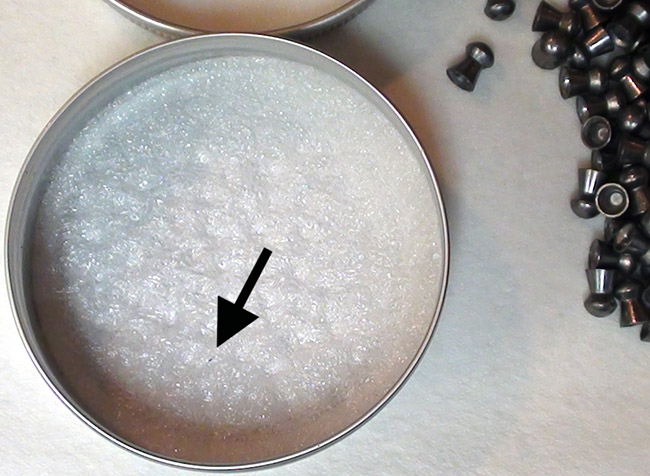
Only one tiny spec of lead in the entire tin!
How we test
With the gains in accuracy budget PCP rifles have been making in the last few years, 25 yards is the new ten yards.
Typically you would start at ten yards with airguns, and move out further as you learn the abilities of the rifle/pellet combination until you reach a distance where the accuracy no longer meets your standards. (Everyone has their own definition of accuracy, some people are thrilled with “minute of soda can” across the back yard, and others are not happy until several .177 caliber pellets go through a .178 diameter hole.)
25 yards
But today I will start at 25, then go out to 50 yards. I cleaned the barrels of both rifles, then fired ten pellets in each rifle to re-season the bores. The groups were shot indoors in a climate controlled storage facility, from a sandbag rest in which the entire gun rested.

The JTS Airacuda in its sandbag rest.
It is no secret I like to shoot steel or reaction targets more than paper because when shooting from a bench for group size I have a tendency to cant the gun sometimes, causing fliers from my error. To prevent that today I hung a string with a weight across the face of the target to help me concentrate on keeping the rifle vertical for every shot.
Ten shots from the JTS Airacuda went into a 0.235-inch group at 25 yards. We were off to a good start!
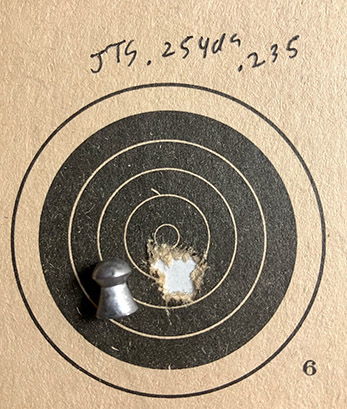
Ten shots from the JTS Airacuda shooting JTS Dead center pellets at 25 yards. The group measures 0.235-inches between centers.
Switching rifles, the Wolverine put ten shots with .22-caliber JTS Dead Center pellets into a 0.234-inch group at 25 yards. So score one point for the Daystate, but not by much. I will call it a tie, as that difference in size can be from my measuring. look at the photos and you decide.

At 25 yards the Daystate Wolverine put 10 JTS Dead Center pellets into a 0.234-inch group.
50 yards
Moving back to 50 yards, I held one ring high on the target, as both guns are zeroed at 50 yards. Again, ten shots from the JTS Airacuda, taking my time. At 50 yards I was able to put ten pellets into a 0.306-inch group, sub MOA. I was so thrilled.
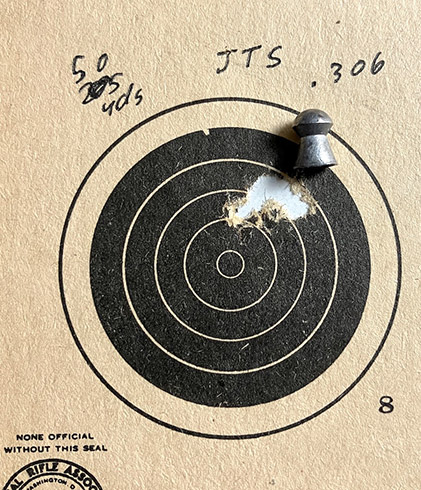
The Aracuda put 10 JTS Dead Center pellets into as 0.306-inch group at 50 yards.
Switching to the Daystate Wolverine, I was concentrating on trying to do everything just right. My first shot went high and left. I was wondering what had happened. I know the Daystate is a one hole gun at 50 yards, but it wasn’t until after shot number four that I remembered the string….. I had forgotten and was canting the rifle without thinking.
Since I had already fired four shots, I kept my same aimpoint and canted angle of the rifle and scope. I finished the group, and the hole never got much larger. Ten shots from the Daystate went into a .341 hole, with my aiming errors.
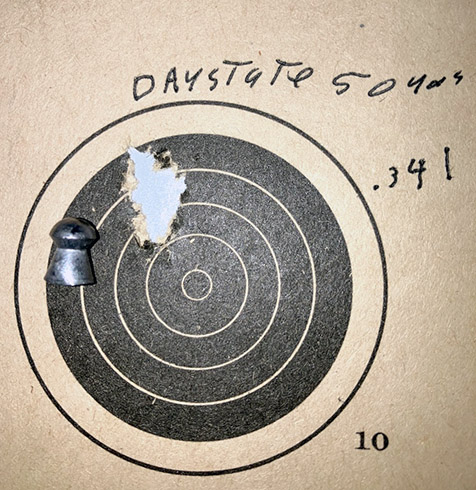
Despite me canting the rifle, the Daystate Wolverine put 10 JTS pellets into 0.341-inches at 50 yards.
I went back to the bench, and shot another ten JTS pellets from the Daystate — this time paying attention to the vertical string. Those ten pellets went into a single hole that measured 0.310-inches between centers, at 50 yards.
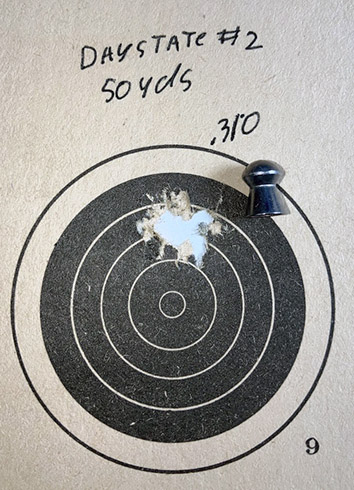
My second group with the Wolverine at 50 yards, paying attention to the vertical string, is 10 pellets in 0.310-inches between centers.
There again, my measurements could be off, I don’t normally shoot paper for score. But with the size of the group visually, not by the numbers, there isn’t much difference
As Paul Harrell on Youtube says, there’s not enough of a difference to make a difference. You be the judge!
The nitty gritty
I have been shooting these guns side-by-side every time I have gone shooting over the last four months. I have well over 1000 rounds through each, mostly at steel targets ranging from 15 yards out to over 100 yards.
The JTS Standard Airacuda has many features that are shared with the Airacuda Max I reviewed a few months ago, other than not being regulated. The Standard rifle also has a five position transfer port adjustment that the regulated Max does not have.
The velocities with JSB 18.1 pellets in this rifle range from an average of 435fps on the lowest setting, all the way up to an average of 940fps on the highest setting. This Airacuda likes to be filled to about 2900psi. More than that and it gets a slight valve lock for the first few shots. With the factory settings my rifle likes position four, at about 910 f.p.s., and that will carry me out to just over 100 yards accurately.
We don’t know who makes the barrel, but they have a winner!
This Daystate Wolverine B model was made back in 2015, it is unregulated, and shoots 18.1 JSB pellets at about 890 f.p.s. It has a Lothar Walther polygonal barrel that’s been sleeved in carbon fiber. If I fill it to the green on the gauge it has a slight valve lock for the first few shots as well. But if I only fill to the middle of the yellow, it’s in its “sweet spot” and is a tack driver.
* The JTS retails for $319; this model Daystate Wolverine last sold for $1695 on clearance price.
* The JTS is a side lever action, it is smooth, but not “silky” smooth.
* The JTS magazines are all metal, and retail for $25.
* The current production Daystate magazine is also full metal and has a quick loading feature, but retails for $120.
Yes the Daystate has a better trigger; yes the Daystate has a nicer finish on the stock, and the action is much smoother. The Daystate will not let you fire the gun unless the bolt is completely closed, and the original factory magazine the rifle shipped with would not index to the next round unless you fired the gun, so you can not load 2 pellets into the barrel accidentally (the new production magazine does not have this feature).
So, is it worth the price difference? That’s something only YOU can decide.
For me, it can be steel, paper or live game, the target doesn’t care if it’s been shot with a $320 rifle or a $1700 rifle. It’s still got a hole in it right where you were aiming….…
Shoot safe, and have FUN.
Ian



Ian,
Thanks for the report. May I suggest that you invest in a bubble level or two?
If you are zeroed at 50 yards, why hold one ring high?
-Yogi
PS what scopes are on your rifles?
The JTS has a UTG Accushot 4-16 on it at the moment.
/product/utg-4-16×44-ao-swat-accushot-rifle-scope-ez-tap-illuminated-mil-dot?a=3900
The Wolverine has a Sniper brand 5-25 first focal plane I wrote a blog about a few months ago. And purchased from the importer texas precision optics, based out of Dallas texas.
It is using the Sun Optics adjustable rings I bought from optics planet, they were the last 2 sets of rings that replicated the. B square adjustable rings Tom wrote about a couple of months ago.
/blog/2022/01/am-i-getting-on-the-right-plane/
I held high so as to not shoot out my aim point.
Ian
Seems strange the Pyramid Air would sell the JTS gun but not the pellets?
At first I thought JTS was a new Korean Boy-band….lol
-Y
The pellets are just hitting the shores, I am sure they will have them soon if they decide to carry them.
Ian,
Are you going to stretch the distance further (like 100 yards) in the hope of finding a difference between the two? Nice shooting. Great tip regarding the string on the target to help fight cant. Although if you are consistent enough the cant will not be an issue.
Siraniko
With JSB pellets I have stretched them out to 105 yards but not indoors, nor for score on paper.
I have not had the opportunity to shoot the JTS pellets that far yet.
On a 2 inch x 4 inch steel plate, (shaped like a man) there is little difference.
The JTS is still just as it was shipped, I have not adjusted anything yet on this one.
The Daystate because of the better trigger and 25x scope is easier to get a round off accurately, and the CONSISTENCY is slightly better than the JTS, but if you do your part and dope the wind, they both are capable of hitting the silhouette 10 out of 10 times.
Ian
45Bravo,
Great report and really nice shooting.
Ian, I could feel the buzz when you wrote, “…sub MOA. I was so thrilled.”
Thank you!
shootski
Ian,
Someone with your knowledge and experience should be able to go inside that JTS Airacuda and smooth things out a bit. I have been thinking about one of those Airacudas, even if they are made in China. 😉
I am quite impressed with the quality control that has been displayed so far with these pellets. I do hope that this continues.
The trick with the weighted string has been in use at RRHFWA for quite some time now. I first used it when I scoped my FWB 601 and was shooting it at 50 yards.
As far as bubble levels go, it is difficult to mount one where it is readily visible and my experience with internal bubble levels is they are difficult to see most of the time. All bubble levels tend to be a time-consuming distraction. I guess that is OK if you have all the time in the world to take the shot, but my experience is live targets do not sit still forever.
I have been into the rifles, and made a couple of videos on youtube to show owners how to change orings, and adjust the regulator, but I not made any adjustments.
Scott (Motorhead on the GTA forum) has been into both of his extensively and made improvements.
I own 2 bubble levels, but they are not mounted on any guns at the moment. I agree i spend more time shifting my focus from the target to the level than i do on the target.
Thats another reason i like steel, its either a hit or a miss, no bragging rights about group sizes..
Ian
Bubble levels s***.
sounds to me like the airacuda is a ringer. shooting 10 rds @50yds into .300 in. is amazing. what was the bar charge? my chinese avenger in .22 will come close to that with jsb 15.89 hades, but i have a regulator and great trigger. using a bubble to level your rifle is a novelty i don’t need but if helps you shoot better..cool
IMMHO, the Airacuda is the winner as it only takes a 206 bar (3000 PSI) fill.
I have three external bubble levels. I do not like them or use them.
45Bravo, I’m impressed by the cleanliness of those JTS pellets!
Shipping must be the roughest packaging test for, well, everything that is sent, and so, I often wonder about the deformation that pellets must undergo inside their tins. I like that JTS cushion their pellets top and bottom. 🙂
The side by side picture is great for comparison and confirms, I still prefer the Standard sporter style.. 🙂
If I were to achieve those little holes in my target card, I would be looking all around to see where most of the other pellets went, ie impressive accuracy 45Bravo, well done! 🙂
Yep, today’s article would sell JTS to me, which has me wondering, is this the whole picture? 🙂
Hihihi, out of a roll of pellets (10 tins) the top of one was dented slightly, but haven’t noticed any of the pellets having damage.
The guns are in my opinion, the best deal going at the moment.
There is a facebook group of owners that are all having the same opinion.
45Bravo, I wonder if anyone offers some sort of power limiter for the JTS Airacuda Standard rifles yet, that, appropriately adjusted, would then make them legal in restricted countries?
It appears that in the United Kingdom the Airacuda Max is available with a claimed 11.4 foot pounds of power, which I assume is achieved via the regulator inside it. So, it’s probably only a matter of time before the same action (regulator) is placed in the Standard stock.
Question for me is, will it become available before I get around to fixing my precharged pneumatic air rifle?
If so, I would certainly, seriously consider one… 🙂
The standard has a 5 position transfer port velocity adjuster.
On its lowest power setting it is the sub 500fps range.
If JTS would fit it with a non adjustable/non removable transfer port limiting it to 520fps that would be right at 10.9ft lbs, that would be under the UK , but I don’t know what the power restrictions are in your country.
But it could theoretically be done.
Thanks 45Bravo, I was actually notified of your reply. 🙂
France allows all airguns to have a power of up to 20 Joules (14 3/4 ft-lb).
European Rulers all have different airgun power ideas, eg Germany 7,5 Joules, Holland no limit, etc… not forgetting rules about calibres, scopes, silencers, stocks, looks, sizes, age, etc, etc… 🙁
Question is, would a manufacturer want to bother enabling thus handicapped customers or just milk the juiciest markets?! 🙂
I love it when a budget underdog equals or betters the performance of an expensive rifle. Can’t believe how cheap you guys get these. We only have the Max version here in the UK and it retails for the equivalent of just over $600, which believe it or not is very low priced.
How do the price of the JTS pellets compare to JSB and other premium ammo?
Ade,
We don’t know the price yet — or at least I don’t. I don’t think the JTS pellets are offered for sale yet.
But I was told at the SHOT Shop last month that they will be a bargain!
BB
Nice shooting! What you do at 50 yards I am aspiring to do at 10.
B.B. here’s a picture of the trigger in the RWS Diana Model 24 J.
I will report on all my trigger adjustment adventures a bit later. Got to get the kiddos to school.
Roamin,
Yep, that’s the same trigger as on the 26. Here’s what I said about that picture.
“The trigger is modular, rather than in pieces.The trigger blade is plastic.”
Last night I fiddled around with the trigger adjustments and took careful notes. Although I don’t have a trigger-pull scale (yet), I ended up with a long first stage, a very short 2nd stage, and almost no over travel. Through all the adjustments, one could have a long or short (the latter makes me nervous) single-stage trigger, or a short first stage and a short second stage with some overtravel. I can understand, though why Diana doesn’t make this trigger any more. At some points in the range of adjustments, the sear would release with the safety on! At other points it seemed as though a feather would set her off. I won’t bore you all with the detail, but this rifle is a sweet one! I was getting groups at 10 yards in the 0.3 to 0.4 inch center-to-center range with a variety of pellets, including some of the cheapies. :o)
One thing is for certain, the front screw is NOT a locking screw for the rear screw! Both screws engage the trigger mechanism in various ways, and you have to find a balance between them to get the pull you want.
The short barrel makes cocking it a bit harder, I imagine, but not too bad. But giving it a short barrel and calling it a Junior model was probably a mistake because little kids could have an issue cocking it on their own. But if an adult is on hand to do the work, a nice trainer–very compact and accurate! There is not much info out there that I could find on it, so if there is interest, I could be persuaded to try my hand at a guest blog. Overall, she’s a good find. I may end up keeping her around for a while.
Roamin,
Interest!
Please email me for guest blog instructions.
BB
Excellent report and excellent shooting Ian!
Good (consistent) equipment is only as good as the skill of the person using it and you obviously know what you are doing!
Beyond 30-35 yards the affects of canting the rifle really becomes noticeable – especially if the scope is mounted on high rings.
I’ve put scope levels on all my longer range rifles and a quick glance at the bubble just before taking up the triggers first stage slack confirms that all is good and ready to go.
In the high precision world of CNC (Computer Numeric Controlled) product is made to tight tolerances by default. Similar to what you are pointing out about airgun quality/price, I suspect that the $70 scope levels are not THAT much better than the $15 ones and the $5 rings are ok as well. Likely, they are all made in the same factory anyways. 😉
I got in a bunch of $3 levels (30mm) and a couple of $4 levels (34mm) that came from China (3-4 weeks free delivery), well packaged, with decent hardware including an allen key to mount them and they have been working fine. I don’t begrudge someone a (fair) profit but at that price difference I could throw away 10 cheap rings and still be ahead.
Thanks for the guest blog Ian!
Hank
Ian /45Bravo,
Enjoyed reading your post particularly due to the setup/focus.
Looking forward to the completion of your Airacuda Max review. (I’m shopping for a decent .25 pesting rifle for raccoon sized pests.)
AP
The .25 Airacuda Max will be shooting against an Fx Crown,
I don’t expect it to win the challenge, for a couple of reasons.
Mostly human error,
I don’t have as much trigger time behind the Max so I have not gotten used to it’s quirks nor have I found where IT LIKES TO SHOOT it’s best.
And the .25 caliber Crown it’s going up against is a purpose built Bench Queen with a 700mm barrel..
Who’s owner has spent a LOT of time in ironing out any issues.
And I have almost NO trigger time behind the Crown.
I do have one chance though, the crown is in a SaberTactical chassis, and seems to be hold sensitive…
Ian.
Ian
Thanks for another fine guest blog.
Just wondering what the transfer port adjustment does or looks like inside. Does it change the port size? Angles? Any idea how many more shots per fill using a low setting?
Deck
I did a video on the transfer port adjustment of the standard, but due to my inexperience in making YouTube videos, my head got in the way of the overhead camera through most of the video.
So I do need to make another.
In its full power setting it’s just a straight shot from the valve to the barrel, as you rotate it, it reduces the opening.
I have NOT shot it on low power much, but I will do that and report back.
Ian
Ian
You are truly an enabler to readers like me. Looking forward to your continued reports.
Deck
Thanks for an interesting review, Ian!
Do the JTS pellets appear to be close copies of the JSB?
I recall in that shooting field target, putting a level on my scope and checking it as I put the rifle in the bipod made a big improvement in my scores. At distance, even a small amount of cant has enough effect to cause a miss.
Yes and no when compared side by side to the JSB. THE ANGLES APPEAR THE SAME,
But the depth of the underside is different than the JSB.
It seems like there has been an explosion of new PCPs, both new guns and new brand names, popping up over the past 10 years or more. I can’t believe that they will all survive, especially the more expensive ones, when these lower-priced imports like JTS can hold their own in the features, performance, and quality departments against the higher-
priced domestic and European models.
Oh well, I can only lament the invisible hand of economics. Some manufacturing concerns in this country are still critically in need of workers and raw materials, and there is no shortage of cheap labor and lack of costly regulation in other parts of the world. But it is nice to find a product where less expensive does not equal low quality. If only they could be made here….
Excellent report Ian, and your shooting is superb! Now I am tempted to pay the folks in Katy a visit. I know that it is a personal thing, but I like that Max. Did you notice a quality difference – precision, trigger, action – between the two? Just curiosity.
Henry
No, they are actually built with the same quality of parts, other than the standard uses a steel pressure tube, and the max uses an alloy pressure tube.
Several of the parts do exchange between the guns.
I am a big avenger advocate, (I own 3) and am now a JTS advocate as well, they are similarly priced, and are marketed towards the same people.
The JTS has the advantage of looking back at 2 years of avenger sales, and see where improvements were made by owners and the company over that time.
A year or two from now it could swing the other way.
Who knows.
But it’s a great time to be an Airgunner with all of the choices we have.
Thanks Ian, and I agree. The problem now is to choose what works best for us. Interesting that you mention the Avenger, I have these two on my sights. The use of real wood is a slight on the JTS side. Perhaps the AvengeX with a 0.177 version and adjustable regulator tips the scale the other way.
Cheers,
Henry
I have been keeping an eye on the Avenge-x.
I hope if I can pester Tyler Patner enough he will send me one to test.
I have a wood stock Avenger in .22, and 2 bullpups one in .177& the other in .22
I like them all.
Airguns are like golf clubs, no one club does everything.
The same with airguns.
.177 has its place and uses, as does .22, and .25.
Some guns are suited for offhand work, some for bench shooting.
Everyone NEEDS more than one gun…..
Ian.